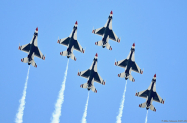Power In the Pines Open House and Air Show 2025
Story by Daniel O. Myers, photos by Mike Colaner
Leaping from one of Joint Base McGuire’s (JBM) own 305th AW C-17s, the U.S. Air Force Academy Wings of Blue Parachute Jump Team opened the 2025 show by bringing the American flag to show center to the playing of the U.S. National Anthem.

Following, JBM showed off their large assets; KC-46 Pegasus (PUDGY) and C-17 Globemaster III (JINX), by taking flight as a tandem aerial refueling demonstration. Later, the USAF’s Altus AFB, OK KC-46A (DASH) and Charleston AFB, SC C-17 (MOOSE) demo teams showcased the capabilities of their respective aircraft. The pilots and crew flying those big planes were trained by the 97th Air Mobility Wing (AMW) at Altus AFB. Since 1943, the 97th AMW has been “Training Exceptional Mobility Airmen” via flying-training squadrons. The 58th Airlift Squadron is comprised of instructor pilots and loadmasters, training Airmen on the C-17 Globemaster III. The 56th Air Refueling Squadron provides formal training for pilots and boom operators on the Air Force’s newest addition to air mobility- the KC-46 Pegasus.

There are currently eighty-nine KC-46s flying with a commitment for a total 179. There are 223 C-17s in active service . On a regular basis, the C-17 and KC-46 execute global reach airland, airdrop, and air refueling mobility for combat, contingency and relief operational forces.

The crowd was then treated to a perspective of military aviation history when a JBM C-17 Globemaster IIl and C-47 Skytrain (DC-3) flew in tight formation. This USAF Legacy Cargo Flight exemplified the evolution of Air Force heavy transport. From Georgetown, DE, B-25 Panchito continued the history lesson with the WWII pacific theater “Doolittle Raider.”

One of JBM’s other tenant unit, the USMC Marine Aircraft Group 49, excited the audience with a heavy lift by a CH-53 Super Stallion Sling Load Demonstration. A USMC AH-1Z Viper and UH-1Y Venom showed how the USMC provides close air and ground support to their troops.

From nearby Atlantic City, a USCG MH-65 DOLPHIN inserted, then extracted a rescue swimmer to and from the surface in a demonstration of Search and Rescue. The USCG MH-65 cleared the runway just in time as Patrick McAlee’s in his “Extreme Flight” Pitts S1S raced the fire and smoke belching 1957 Chevy Jet Truck down the runway.

Before the flying got underway, 165,000 weekend attendees were kept entertained with plenty of military displays to see on McGuire’s huge ramp. Jammed packed with the joint base’s Navy, Air Force, Army and Marine static aircraft; the public had an opportunity to meet the receptive pilots and personnel who were all to happy to show what they do best- protect our nation.

One of those aircraft on the ramp was a JBM based Navy Reserve (USNR) VR-64 KC-130T. Between 1990 and 1996, the Navy acquired twenty-four C-130Ts which until recently were used exclusively for cargo missions. There are currently sixteen C-130Ts and eleven KC-130Ts in the USN and USMC inventory. Five other KC-130T aircraft are operated by two Navy support test and evaluation wings. VR-64 has a current count of four KC-130s with two more expected from the USMC. Along with the C-130, VR squadrons also fly C-140s. Both aircraft fly 80% of their missions overseas with 20% of those hauling hazardous (HZ) cargo. HZ cargo has a broadly wide definition consisting if everything from HZ chemicals, to oil, to batteries.
With the help of an upgraded new NP2000 eight-blade composite propeller on the KC-130T, the USNR will now take over the aerial refueling role from the USMC. Testing of the new propeller is currently being conducting by the Naval Air Warfare Center Aircraft Division at NAS Patuxent River, MD. USMC KC-130Ts Hercules tankers are in the process of being transferred to the USNR from the USMC and upgraded with the new NP2000 eight-blade propeller. One of the criteria for transitioning the aerial refueling role to the USN from the USMC is due to the VR squadrons having more equipment and personnel than their USMC counterparts. However, for KC-130 aerial refueling missions, navy mechanical (MX) personnel will have to undergo intensive MX training for the “T.” During aerial refueling missions, Flight Engineers will operate the drogue hose while the Load Masters will be responsible for monitoring the aerial refueling as Aerial Refueling Observers peering out the side doors or back ramp if opened.
The Navy KC-130T’s will eventually be cleared for aerial refueling USN and USMC F-35B/C, F/A-18E/F, EA-18G, AV-8B jets along with C-2, E-2C/D aircraft and CH-53, CH-47, H-60 helicopters as well as the V-22 tilt-rotor. The main emphasis on this new mission is the V-22, as the other aircraft listed above can already be aerial refueled with the KC-135R/T and KC-46A. Future USN Reserve’s inventory of KC-130Ts will be transferred from the two reserve USMC aerial refueler/transport squadrons that are now operating the KC-130J. With their new mission, VR-64 will add another element to JBM’s aerial refueling missions.

The USAF Thunderbirds Aerial Demonstration Team closed out the show by starting out with a high show, then transitioning low. Their routine consisted of hot, loud, fast maneuvers that incorporated three sneak passes after a near perfect cross-over followed by another “air-concussion” sneak pass.

















































